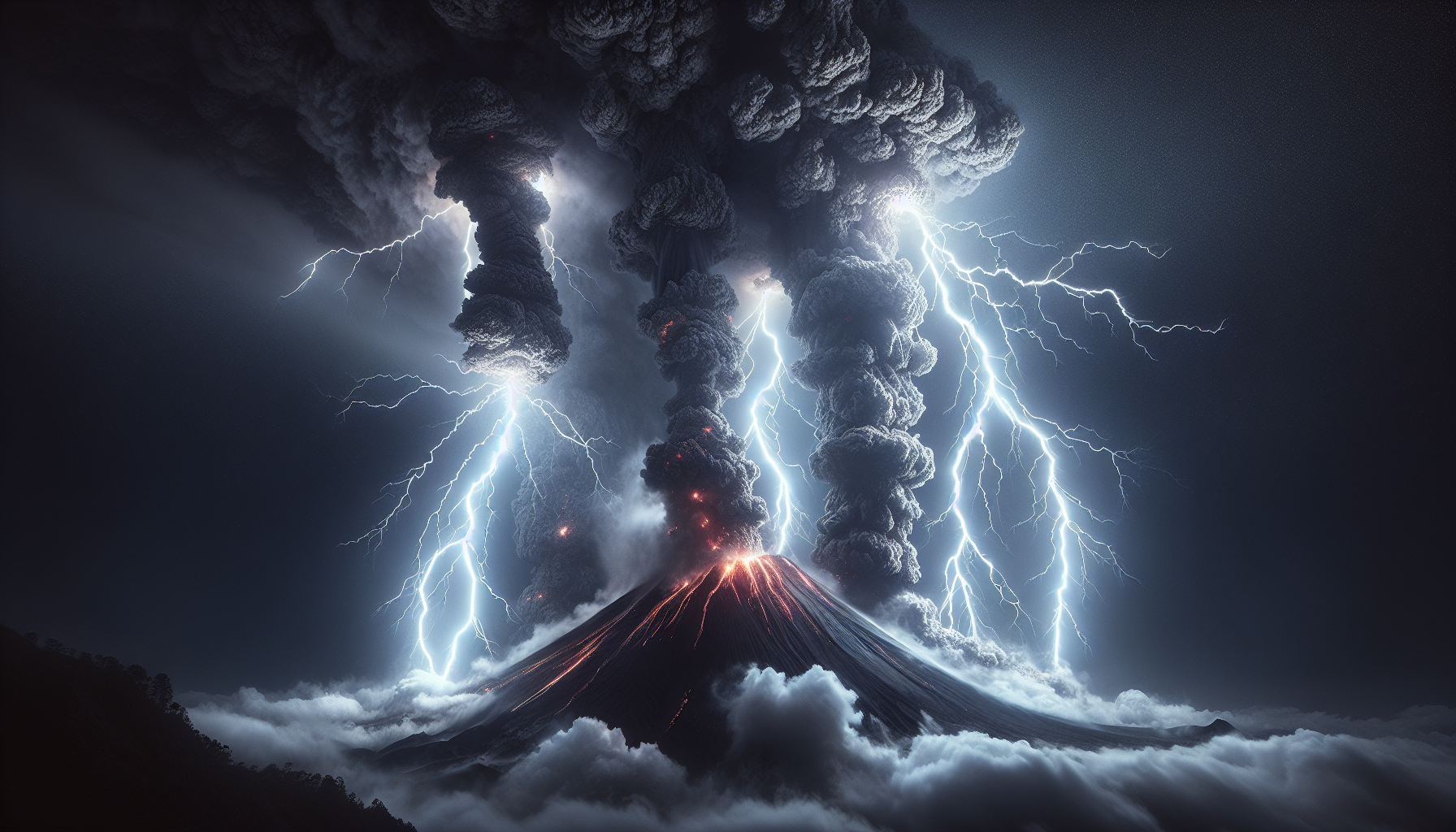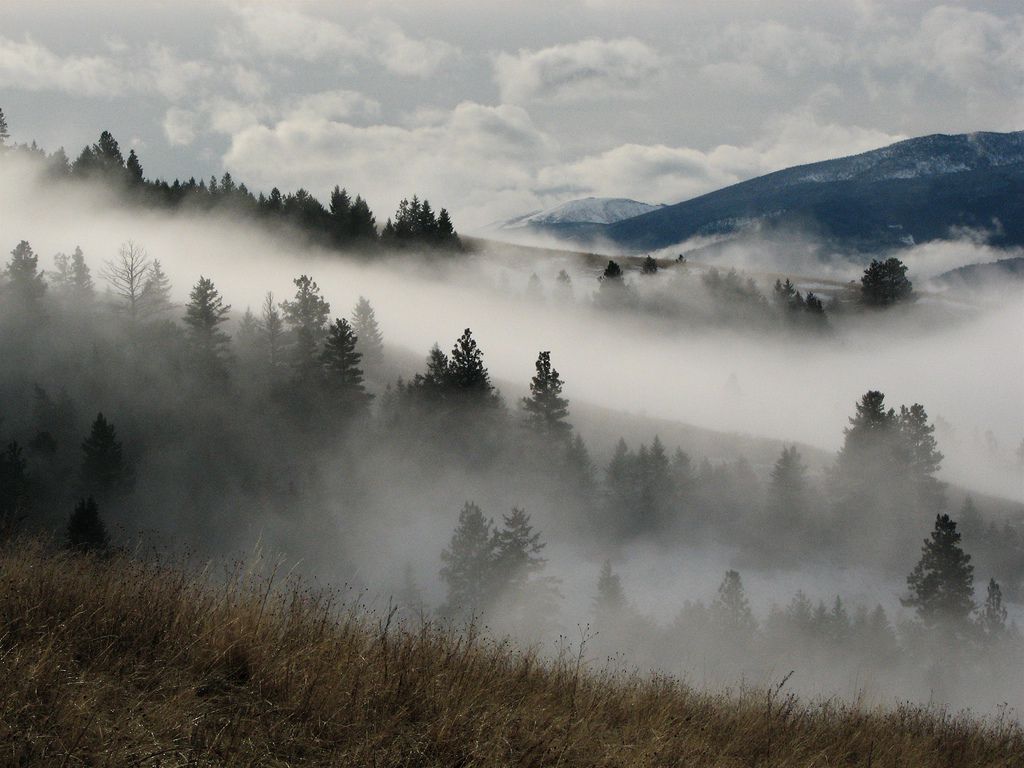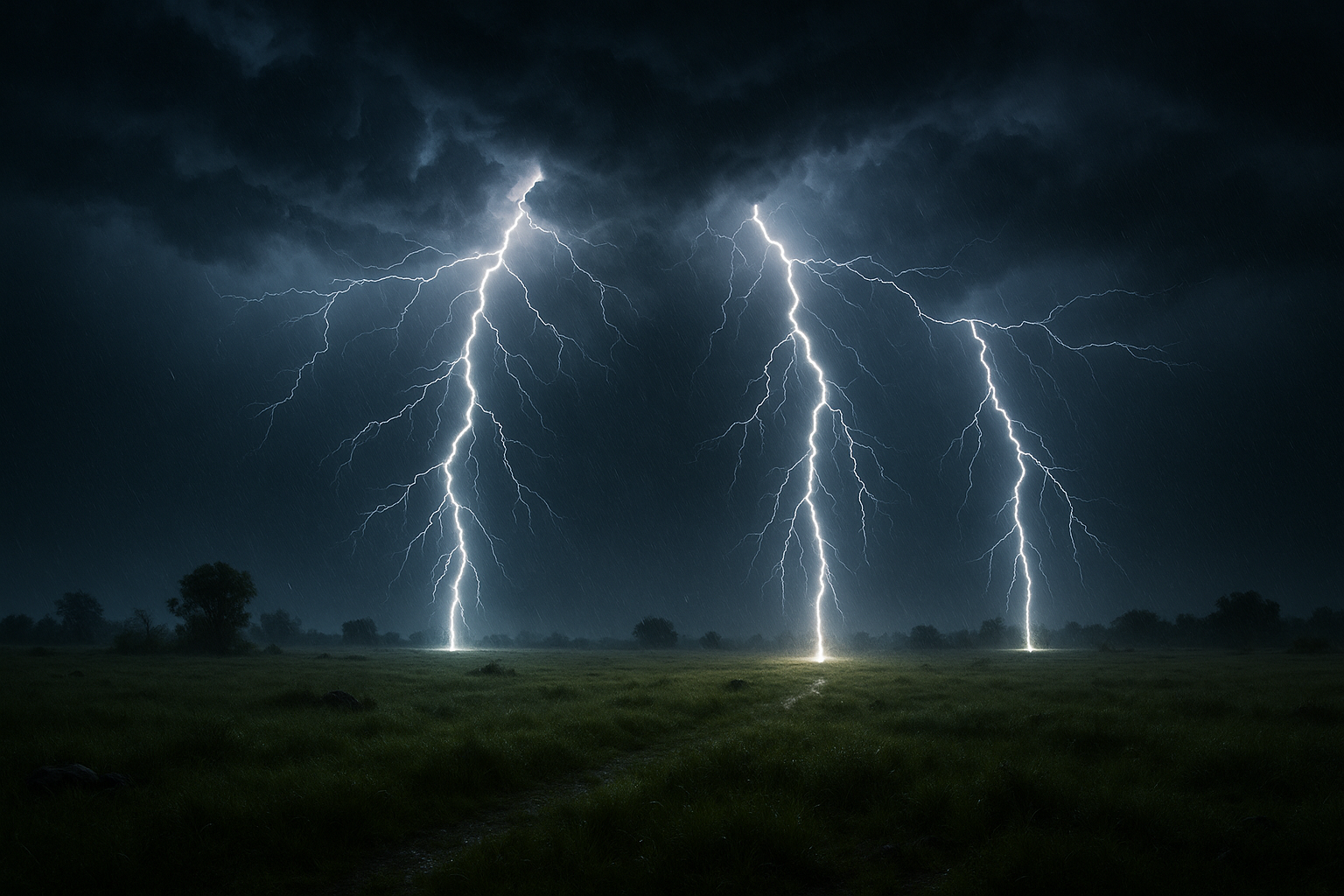In the vast and intricate tapestry of our planet’s natural phenomena, few displays are as awe-inspiring and enigmatic as the electrifying dance of lightning within volcanic ash clouds. 🌋⚡ This mesmerizing spectacle is a vivid reminder of the raw power and beauty that nature can unleash, often leaving both scientists and onlookers in sheer wonder. Imagine standing at a safe distance from a towering volcano, witnessing the sky come alive with a symphony of thunder and flickering lights, set against a backdrop of billowing ash plumes. It’s a scene that has captivated human imagination for centuries, prompting us to explore and understand the forces at play beneath the Earth’s crust.
At the heart of this captivating phenomenon is the interplay between volcanic eruptions and electrical discharges, a subject that continues to intrigue volcanologists, meteorologists, and physicists alike. But what exactly causes lightning to streak through the ash-laden skies during a volcanic eruption? The answer lies in a complex web of geological and atmospheric processes that work in tandem to create this electrifying display. As volcanic ash and gases are ejected into the atmosphere, they generate a dynamic environment where friction, static electricity, and charged particles culminate in the dramatic flashes of lightning we observe. This article delves into the science behind these interactions, shedding light on the mechanisms that ignite the skies above active volcanoes.
To truly appreciate the marvel of volcanic lightning, it’s essential to explore the conditions that give rise to such a spectacle. We’ll journey into the depths of volcanic eruptions, examining how the immense pressure and heat within the Earth’s mantle propel molten rock, or magma, to the surface. As this magma erupts, it fragments into a fine ash that is carried high into the atmosphere, creating a fertile ground for electrical activity. But the story doesn’t end there. The movement and collision of ash particles, combined with the presence of water vapor and other gases, create a charged environment that is ripe for the formation of lightning. Throughout this article, we’ll unravel the science behind these processes, offering a detailed understanding of how and why volcanic lightning occurs.
The significance of volcanic lightning extends beyond its visual spectacle. It holds valuable insights into the behavior of volcanic eruptions and the potential hazards they pose. By studying the characteristics of lightning within ash clouds, scientists can gain crucial information about the intensity and evolution of an eruption, which is vital for assessing the risks to nearby communities and aviation. This article will explore the practical implications of volcanic lightning research, highlighting the advancements in monitoring and predicting volcanic activity. From the development of specialized instruments to the integration of satellite technology, we’ll discuss how scientists are harnessing the power of lightning to enhance our understanding of these formidable natural events.
As we embark on this exploration of volcanic lightning, we invite you to delve into the extraordinary synergy between Earth’s geological forces and atmospheric dynamics. By unraveling the mysteries of this electrifying phenomenon, we not only deepen our appreciation for the complexities of nature but also underscore the importance of continued research and collaboration among scientists worldwide. So, prepare to be captivated by the interplay of fire and electricity, as we uncover the secrets of lightning inside volcanic ash clouds and celebrate the boundless wonders of our planet. 🌍✨
The Enigmatic Interaction of Lightning and Volcanic Ash
Lightning during volcanic eruptions is one of nature’s most spectacular phenomena, a mesmerizing interplay of fire and electricity that can illuminate the skies above an erupting volcano. While the sight is breathtaking, the science behind volcanic lightning is just as fascinating. The formation of this phenomenon involves a complex set of conditions and processes that combine the earth’s geological and meteorological systems in a powerful display of energy.
Volcanic lightning occurs when an eruption spews vast quantities of ash into the atmosphere. These ash particles collide with each other, a process known as triboelectric charging, which generates static electricity. This static electricity accumulates until it is strong enough to overcome the resistance of the air, discharging as a bolt of lightning. The resulting spectacle is both a visual marvel and a scientific curiosity that researchers continue to study.
The intensity and frequency of volcanic lightning depend on several factors, including the composition of the volcanic ash, the size of the eruption, and the weather conditions at the time of the eruption. For example, eruptions that produce fine ash are more likely to generate lightning because the smaller particles have a larger surface area for collisions. Similarly, weather conditions that enhance the formation of thunderstorms can increase the likelihood of lightning. To better understand these factors, scientists have been conducting field studies and experiments to simulate volcanic lightning in laboratory settings.
Understanding the Science Behind Volcanic Lightning
To delve deeper into the science of volcanic lightning, it’s essential to examine the role of ash particles in the electrical charging process. When volcanic ash is expelled into the atmosphere, the individual particles become charged through a mechanism called frictional charging or triboelectric charging. As these particles collide and rub against each other, electrons are transferred from one particle to another, creating an imbalance of charges.
This charge separation leads to the formation of an electric field within the ash cloud. When the electric field becomes strong enough, it can initiate a breakdown in the air, resulting in a lightning strike. The lightning not only neutralizes the charge imbalance but also creates a pathway for subsequent electrical discharges. This process is similar to the way lightning occurs in thunderclouds, where ice and water droplets play a role in charge separation.
Research into volcanic lightning has also revealed that the chemical composition of the ash can influence the charging process. For instance, ash that contains high levels of silicate minerals tends to charge more efficiently due to their electrical properties. By studying these interactions, scientists can gain insights into the conditions that lead to volcanic lightning and potentially develop predictive models for future eruptions.
The Role of Weather and Atmospheric Conditions
Weather conditions play a crucial role in the formation of volcanic lightning. Thunderstorms, with their intense updrafts and turbulence, provide an ideal environment for lightning to occur. When a volcanic eruption coincides with such weather conditions, the likelihood of lightning increases significantly. The interaction between the volcanic ash cloud and the atmospheric environment can enhance the electrical charging process and lead to more frequent lightning strikes.
One of the critical factors influencing volcanic lightning is the moisture content in the atmosphere. High humidity levels can lead to the formation of ice crystals in the ash cloud, which can further facilitate charge separation. The presence of ice can enhance the triboelectric charging process, increasing the probability of lightning. Additionally, wind patterns and atmospheric pressure can affect the dispersion of the ash cloud and the concentration of particles, impacting the likelihood of electrical discharges.
Furthermore, the temperature of the ash cloud can influence the formation of lightning. High temperatures can lead to the vaporization of certain minerals in the ash, altering the chemical composition and affecting the charging process. By understanding the interplay between these factors, scientists can improve their ability to forecast volcanic lightning and assess the potential hazards associated with volcanic eruptions.
Exploring Volcanic Lightning Through Research and Technology
Advancements in technology have enabled scientists to study volcanic lightning with greater precision and accuracy. High-speed cameras, lightning detection networks, and satellite imagery are among the tools used to monitor and analyze this phenomenon. These technologies allow researchers to capture detailed images of lightning strikes, measure their intensity, and track their frequency over time.
One of the significant breakthroughs in volcanic lightning research has been the development of lightning mapping arrays. These systems use a network of sensors to detect the radio frequency signals emitted by lightning discharges. By triangulating these signals, scientists can create three-dimensional maps of lightning activity, providing valuable insights into the dynamics of volcanic eruptions.
Additionally, laboratory experiments have been conducted to simulate volcanic lightning under controlled conditions. By recreating the conditions of an eruption, researchers can study the mechanisms of charge generation and the factors that influence lightning formation. These experiments have contributed to a better understanding of the processes involved and have helped validate theoretical models of volcanic lightning.
Implications of Volcanic Lightning for Aviation and Safety
Volcanic lightning poses significant challenges for aviation safety. The presence of ash clouds can disrupt air travel by reducing visibility and damaging aircraft engines. Lightning strikes within these clouds can further complicate navigation and pose risks to aircraft systems. As a result, understanding and predicting volcanic lightning is essential for ensuring the safety of air travel during volcanic eruptions.
One of the primary concerns for aviation is the risk of lightning-induced fires on aircraft. Lightning strikes can ignite fuel vapors or damage electrical systems, leading to potential hazards. To mitigate these risks, aircraft are equipped with lightning protection systems, including conductive paths and grounding mechanisms, to safely dissipate electrical charges.
In addition to aviation, volcanic lightning can also have implications for public safety and emergency response. The presence of lightning can increase the risk of wildfires, particularly in dry regions with flammable vegetation. Moreover, the electrical discharges can disrupt communication networks and power grids, posing challenges for emergency responders. By understanding the conditions that lead to volcanic lightning, authorities can develop strategies to minimize these risks and ensure public safety.
Case Studies of Notable Volcanic Lightning Events
Throughout history, there have been several notable instances of volcanic lightning that have captured the attention of scientists and the public alike. These events provide valuable case studies for understanding the conditions that lead to this phenomenon and its potential impacts. One such example is the eruption of Mount Vesuvius in 79 AD, which was accompanied by reports of intense lightning activity. Historical accounts describe the sky as being filled with fire and lightning, adding to the drama of the catastrophic event.
More recent examples include the 2010 eruption of Eyjafjallajökull in Iceland, which produced dramatic lightning displays visible from miles away. This eruption disrupted air travel across Europe and highlighted the challenges posed by volcanic ash clouds. The lightning associated with this event provided valuable data for researchers studying the interactions between ash particles and atmospheric conditions.
Another significant event was the 2015 eruption of Calbuco in Chile, which was accompanied by a spectacular lightning display. The eruption’s timing, combined with favorable weather conditions, created an ideal environment for lightning formation. These case studies demonstrate the diversity of conditions that can lead to volcanic lightning and the importance of continued research in this area.
| Volcano | Year | Location | Lightning Intensity |
|---|---|---|---|
| Mount Vesuvius | 79 AD | Italy | High |
| Eyjafjallajökull | 2010 | Iceland | Moderate |
| Calbuco | 2015 | Chile | High |
Current Challenges and Future Directions in Volcanic Lightning Research
Despite significant advancements in our understanding of volcanic lightning, several challenges remain. One of the primary challenges is the difficulty in obtaining real-time data during eruptions. The remote and hazardous nature of volcanoes often limits access for researchers, making it challenging to deploy instruments and collect data during an active eruption. As a result, many studies rely on remote sensing technologies and post-eruption analysis to gather information.
Another challenge is the complexity of modeling volcanic lightning. The interactions between ash particles, atmospheric conditions, and electrical fields are highly dynamic and can vary significantly between eruptions. Developing accurate models that can predict lightning activity requires a comprehensive understanding of these processes and their interactions. Continued research and collaboration between geologists, meteorologists, and physicists are essential for overcoming these challenges.
Looking to the future, there is a growing interest in using machine learning and artificial intelligence to improve volcanic lightning prediction. By analyzing large datasets from past eruptions, researchers hope to identify patterns and develop predictive algorithms that can anticipate lightning activity. These advancements could enhance our ability to forecast volcanic eruptions and mitigate their impacts on aviation and public safety.
Conclusion: Embracing the Mysteries of Volcanic Lightning
The electrifying phenomenon of volcanic lightning continues to captivate the imagination and inspire scientific inquiry. As researchers delve deeper into the mysteries of this natural spectacle, we gain a greater appreciation for the power and complexity of the Earth’s geological and meteorological systems. By embracing the challenges and opportunities presented by volcanic lightning, we can continue to unlock the secrets of this awe-inspiring phenomenon and enhance our understanding of the world around us.
For more insights into the fascinating phenomenon of volcanic lightning, be sure to watch this informative video from the “Veritasium” channel on YouTube: The Science of Volcanic Lightning.

Conclusion
The electrifying phenomenon of lightning within volcanic ash is a testament to the awe-inspiring power and complexity of nature. As we have explored throughout this article, the intersection of volcanic activity and electrical storms presents a unique and captivating spectacle that not only intrigues scientists but also captivates the imagination of the general public.
To recap, we began by examining the basic mechanisms behind volcanic lightning. When a volcano erupts, it spews forth ash, gas, and lava, creating a chaotic environment where particles collide and generate static electricity. This process leads to the formation of lightning within the volcanic plume, a dramatic display of nature’s power. The interplay of these forces is not only mesmerizing to witness but also offers valuable insights into the earth’s atmospheric processes.
We delved into the science behind why volcanic lightning occurs, discussing how the rapid movement of ash particles creates conditions ripe for electrical charge separation. As ash particles rub against each other, they become electrically charged, leading to the discharge of electricity in the form of lightning. This phenomenon, while visually stunning, is also an important subject of study for volcanologists and meteorologists, as it can provide critical information about the dynamics of volcanic eruptions.
Moreover, we explored the technological advancements that have allowed scientists to study this phenomenon more closely. With the advent of high-speed cameras and advanced monitoring equipment, researchers can now capture detailed images and data of volcanic lightning as it occurs. This has led to a deeper understanding of how these electrical storms form and evolve, shedding light on the broader implications for both volcanic activity and atmospheric science.
The importance of understanding volcanic lightning extends beyond mere academic interest. It has practical applications in improving volcanic eruption forecasts and mitigating the risks associated with volcanic activity. By studying the electrical signals generated during eruptions, scientists can better predict the behavior of volcanoes, potentially saving lives and reducing the economic impact of volcanic disasters.
Furthermore, the study of volcanic lightning contributes to our understanding of lightning in general, offering insights into the behavior of electrical storms in other contexts. This has implications for fields ranging from climate science to aerospace engineering, highlighting the interconnectedness of natural phenomena.
As we conclude our exploration of this electrifying topic, it is important to recognize the significance of continued research in this field. Volcanic lightning serves as a reminder of the dynamic and unpredictable nature of our planet, urging us to remain vigilant and proactive in our efforts to understand and adapt to these natural forces.
We encourage you, the reader, to delve deeper into this fascinating subject and consider the broader implications of our findings. Whether you are a scientist, a student, or simply someone with a curiosity about the natural world, there is much to learn and discover about the power and beauty of volcanic lightning. By sharing this knowledge and engaging in discussions about its implications, we can foster a greater appreciation for the wonders of nature and the importance of scientific inquiry.
Feel free to leave your thoughts in the comments section below, or share this article with others who may find it interesting. Together, we can continue to explore and celebrate the remarkable phenomena that our planet has to offer. 🌋⚡
For further reading and to explore more about this topic, consider visiting these resources:
– National Geographic: Volcanic Lightning
– United States Geological Survey (USGS): Volcano Hazards Program
– Nature: Volcanic Ash and Lightning
Let us remain inspired by the power of nature and motivated to continue our pursuit of knowledge and understanding. 🌍✨
Toni Santos is a visual storyteller and artisan whose creations celebrate the poetry of the natural world. Through his thoughtful artistic lens, Toni captures the elegance of botanical forms, transforming them into meaningful expressions of symbolism, resilience, and timeless beauty.
His journey is deeply rooted in a passion for flora and the mysteries they carry. From the shape of a petal to the curve of a vine, each design Toni brings to life reflects a deeper narrative — one of growth, transformation, and harmony with nature. Whether crafting symbolic floral jewelry, enchanted botanical illustrations, or seasonal visual studies, Toni’s work evokes the quiet magic found in Earth’s most delicate details.
With a background in handcrafted artistry and visual design, Toni blends technique with intention. His creations do more than decorate — they speak, often inspired by ancient meanings behind flowers, the cycles of the seasons, and the invisible bonds between nature and spirit.
As the creative voice behind Vizovex, Toni shares this botanical journey with the world, offering curated stories, handcrafted collections, and thoughtful articles that help others reconnect with nature’s symbolism and artistic essence.
His work is a tribute to:
The quiet power of flowers and their messages
The art of visual symbolism in everyday life
The beauty of slowing down to see what’s hidden in plain sight
Whether you’re an artist, a nature lover, or someone drawn to the deeper meanings behind the natural world, Toni welcomes you to explore a space where aesthetics meet soul — one petal, one story, one creation at a time.





